Count of Barcelona
| History of Catalonia |
|---|
 |
| Timeline |
The Count of Barcelona (Catalan: Comte de Barcelona, Spanish: Conde de Barcelona, French: Comte de Barcelone, Latin: Comites Barcinonenses) was the ruler of the County of Barcelona and, by extension, the Principality of Catalonia for much of Catalan history, from the 9th century until the 18th century.
History[]

The County of Barcelona was created by Charlemagne after he had conquered lands north of the river Ebro and Barcelona, after a siege in 801. These lands, called the Marca Hispanica, were partitioned into various counties, of which the count of Barcelona, usually holding other counties simultaneously, eventually obtained the primacy over the region. As the county became hereditary in one family, the bond of the counts to their Frankish overlords loosened, especially after the Capetian dynasty supplanted the Carolingians.
In the 12th century, the counts of Barcelona became kings of Aragon through inheritance, establishing the Crown of Aragon. In 1258, the king of France relinquished his claim of feudal authority over the county in the Treaty of Corbeil. The counts were also hereditary kings of Castile from the 16th century, eventually forming the Kingdom of Spain. The title of count of Barcelona remained one of the many hereditary titles of the Spanish monarchy.
In the 20th century, the title regained some prominence when Juan de Borbón, the exiled heir to the Spanish throne, adopted the title of count of Barcelona. In doing so, he claimed a historical royal title without claiming to be the current king of Spain, especially after his son Juan Carlos became the prospective successor of the then-ruler of Spain, Francisco Franco. In 1977, after Juan Carlos had become king upon Franco's death in 1975, he officially awarded the comital title to his father, who had renounced his rights to the throne. Juan held that title until his death in 1993, when it reverted to Juan Carlos. Juan de Borbón's widow used the title countess of Barcelona until her death in 2000.
List of counts of Barcelona[]
Non-dynastic, 801–878[]
| Name | Portrait | Reign | Notes |
|---|---|---|---|
| Bera | 801–820 | son of , brother of ,[citation needed] also Count of Razès and Conflent (790–820), Girona, Besalú, Ausona (812/817–820), deposed. | |
| Rampon (Rampó) |
820–826 | also Count of Girona and Besalú | |
| Bernard I (Bernat I) |
826–832 | son of William of Gellone, also margrave of Septimania (834–835) and Imperial Chamberlain (829–830), deposed. | |
| Berenguer | 832–835 | also Count of Toulouse. | |
| Bernard I (Bernat I) |
836–844 | restored, executed on orders of Charles the Bald. | |
| Sunifred | 844–848 | son or son-in-law of Belló of Carcassone, also Count of Ausona, Besalú, Girona, Narbonne, Agde, Béziers, Lodève, Melgueil, Cerdanya, Urgell, Conflent and Nîmes. | |
| William (Guillem) |
848–850 | son of Bernard I, also Count of Toulouse (844–850), rebelled and was killed. | |
| Aleran | 850–852 | also Count of Empúries and Roussillon and Margrave of Septimania. | |
| Odalric | 852–858 | son of Hunfrid, Margrave of Istria, also Count of Girona, Roussillon, Empúries and Margrave of Septimania. | |
| Humfrid | 858–864 | son of , also Count of Girona, Empúries, Roussillon, and Narbonne and Margrave of Gothia. | |
| Bernard II (Bernat II) |
865–878 | son of Bernard of Poitiers also Count of Girona and Margrave of Gothia and Septimania, rebelled. |
House of Sunifred, 878–1162[]
The neutrality of this article is disputed. (December 2019) |
| Name | Portrait | Birth | Marriages | Death |
|---|---|---|---|---|
| Wilfred I the Hairy (Guifré el Pilós) 878 –897 |
 |
c.840 Girona Disputed filiation |
Guinidilda 877 10 children |
897 Tremp aged 46–47 |
| Wilfred II Borrell I (Guifré II Borrell) 897 –26 April 911 |
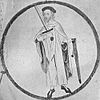 |
c.874 Girona First son of Wilfred I and Guinidilda |
Garsenda 898 1 child |
26 April 911 Barcelona aged 36–37 |
| Sunyer 26 April 911 –947 |
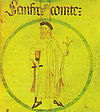 |
c.890 Girona Sixth son of Wilfred I and Guinidilda |
Aimilda 914 1 child Richilde 925 5 children |
15 October 950 Lagrasse aged 59–60 |
| Miro I 947 –966 |
 |
c.926 Barcelona Second son of Sunyer and Richilde |
Unmarried | 966 aged 39–40 |
| Borrell II 947 –992 (joint rule 947-966) |
 |
c.927 Barcelona Third son of Sunyer and Richilde |
Luitgarde 968 5 children |
992 aged 64–65 |
| Ramon Borrell 988 –8 September 1017 (joint rule 988–992) |
 |
26 May 972 Girona Son of Borrell II and Luitgarde |
Ermesinde of Carcassonne 993 2 children |
8 September 1017 Barcelona aged 45 |
| Ermesinde of Carcassonne 993–1021 1035–1039 (joint rule 993–1017); (regent 1017–1021, 1035–1039) |
 |
972 Carcassonne Daughter of Roger I of Carcassonne and Adelaide of Melgueil |
Ramon I Borrell III 993 2 children |
1 March 1058 Sant Quirze de Besora aged 85–86 |
| Berenguer Ramon I the Crooked El Corbat 8 September 1017 –31 March 1035 (under regency of Ermesinde of Carcassonne 1017–1021) |
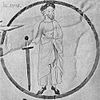 |
1004 Son of Ramon Borrell and Ermesinde of Carcassonne |
Sancha of Castile 1021 2 children Guisla of Lluçá 1027 3 children |
31 March 1035 Barcelona aged 30–31 |
| Ramon Berenguer I the Old El Vell 31 March 1035 –26 June 1076 (under regency of Ermesinde of Carcassonne 1035–1039) |
 |
1023 Girona Son of Berenguer Ramon I and Sancha of Castile |
Élisabeth de Nîmes 1039 3 children Blanche de Narbonne 16 March 1051 (annulled 1052) no children Almodis de La Marche 1056 Barcelona (together since 1052) 4 children |
26 June 1076 Barcelona aged 52–53 |
| Almodis de La Marche 1052 –16 October 1071 (joint rule) |
 |
c.1020 Toulouse Daughter of Bernard I de La Marche and Amélie de Rasès |
Hugh V of Lusignan 1038 (annulled c.1040) 3 children Pons, Count of Toulouse 1040 or 1045 (annulled 1052) 4 children Ramon Berenguer I 1056 Barcelona (together since 1052) 4 children |
16 October 1071 Barcelona aged 50–51 |
| Ramon Berenguer II the Towhead El Cap d'Estopes 26 June 1076 –6 December 1082 |
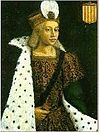 |
c.1053 Girona First/Second son of Ramon Berenguer I and Almodis de La Marche |
Mafalda of Apulia-Calabria 1078 Barcelona 3 children |
6 December 1082 Sant Feliu de Buixalleu aged 28–29 |
| Berenguer Ramon II the Fratricide el Fratricida 26 June 1076 –1097 (joint rule 1076–1082) |
c.1053 First/Second son of Ramon Berenguer I and Almodis de La Marche |
Unmarried | 1097 Jerusalem aged 43–44 | |
| Ramon Berenguer III the Great El Gran 6 December 1082 –19 July 1131 (joint rule 1082–1097) |
 |
11 November 1082 Rodez Son of Ramon Berenguer II and Mafalda of Apulia-Calabria |
María Díaz de Vívar 1103 2 children Almodis de Mortain 1106 no children Douce I, Countess of Provence 3 February 1112 Arles 7 children |
19 July 1131 Barcelona aged 48 |
| Ramon Berenguer IV the Saint El Sant 19 July 1131 –6 August 1162 |
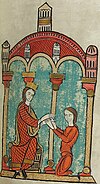 |
c.1113 Barcelona or Rodez Son of Ramon Berenguer III and Douce I, Countess of Provence |
Petronilla of Aragon August 1050 Lleida 5 children |
6 August 1162 Borgo San Dalmazzo aged 48–49 |

The succession of Ramon Berenguer IV and Petronilla led to the creation of the Crown of Aragon.
House of Barcelona, 1164–1410[]
| Name | Portrait | Birth | Marriages | Death |
|---|---|---|---|---|
| Alphonse I the Troubadour El Trobador 18 July 1164 – 25 April 1196 |
 |
1-25 March 1157 Huesca son of Ramon Berenguer IV of Barcelona and Petronilla of Aragon |
marriage agreement with Mafalda of Portugal 1159-1162, not fulfilled Sancha of Castile 18 January 1174 Zaragoza 7 children |
25 April 1196 Perpignan aged 44 |
| Peter I the Catholic El Catòlic 25 April 1196 – 13 September 1213 |
 |
July 1178 Huesca son of Alfons I and Sancha of Castile |
Marie of Montpellier 15 June 1204 2 children |
12 September 1213 Battle of Muret aged 35 |
| James I the Conqueror El Conqueridor 13 September 1213 – 27 July 1276 |
 |
2 February 1208 Montpellier son of Peter I the Catholic and Marie of Montpellier |
marriage agreement with Aurembiaix, Countess of Urgell 1209, not fulfilled Eleanor of Castile 6 February 1221 Ágreda 1 child Violant of Hungary 8 September 1235 Barcelona 10 children Teresa Gil de Vidaure (lover, then wife) 1255 (uncanonical marriage, repudiated 1260) 2 children |
27 July 1276 Valencia aged 68 |
| Peter II the Great El Gran 27 July 1276 – 2 November 1285 |
 |
July or August 1240 Valencia son of James I and Violant of Hungary |
Constance of Sicily 13 June 1262 Montpellier 6 children |
2 November 1285 Vilafranca del Penedès aged 45 |
| Alphonse II the Liberal El Liberal 2 November 1285 – 18 June 1291 |
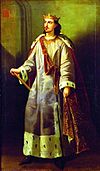 |
4 November 1265 Valencia son of Peter II and Constance of Sicily |
Eleanor of England 15 August 1290 (by proxy and not consummated; death of the groom during bride's way to Aragon) |
18 June 1291 Barcelona aged 27 |
| James II the Fair El Just 18 June 1291 – 2 November 1327 |
 |
10 August 1267 Valencia son of Peter II and Constance of Sicily |
Isabella of Castile 1 December 1291 Soria No children Blanche of Anjou 29 October or 1 November 1295 Vilabertran 10 children Marie de Lusignan 15 June 1315 (by proxy) Nicosia 27 November 1315 (in person) Girona No children Elisenda de Montcada 25 December 1322 Tarragona No children |
5 November 1327 Barcelona aged 60 |
| Alphonse III the Kind El Benigne 2 November 1327 – 24 January 1336 |
 |
2 November 1299 Naples son of James II of Aragon and Blanche of Anjou |
Teresa d'Entença 1314 Lerida 7 children Eleanor of Castile 5 February 1329 Tarazona 2 children |
27 January 1336 Barcelona aged 37 |
| Peter III the Ceremonious El Cerimoniós 24 January 1336 – 5 January 1387 |
 |
5 October 1319 Balaguer son of Alphonse III and Teresa d'Entença |
Maria of Navarre 25 July 1337 Zaragoza 2 children Leonor of Portugal 14 or 15 November 1347 Barcelona No children Eleanor of Sicily 27 August 1349 Valencia 4 children Sibila of Fortia 11 October 1377 Barcelona 3 children |
5 January 1387 Barcelona aged 68 |
| John the Hunter El Caçador 5 January 1387 – 19 May 1396 |
 |
27 December 1350 Perpignan son of Peter III and Eleanor of Sicily |
marriage agreement with Jeanne-Blanche of France 1370-1371, not fulfilled Martha of Armagnac 24 June 1373 Barcelona 5 children Violant of Bar 2 February 1380 Perpignan 7 children |
19 May 1396 Foixà aged 46 |
| Martin the Humanist l'Humà 19 May 1396 – 31 May 1410 |
 |
1356 Girona son of Peter III and Eleanor of Sicily |
Maria de Luna 13 June 1372 Barcelona 4 children Margaret of Prades 17 September 1409 Barcelona No children |
31 May 1410 Barcelona aged 54 |
Martin was the last direct descendant of Wilfred the Hairy to rule; died without legitimate heirs (interregnum 31 May 1410 – 24 June 1412). By the Compromise of Caspe of 1412 the County of Barcelona and all its associated dominions passed to a branch of the House of Trastámara.
The County of Barcelona formed a constituent part of the Crown of Spain under the rule of the House of Habsburg, until the Nueva Planta decrees (1707 and 1716), when Philip de Bourbon declared that all the territories from the Crown of Aragon should merge into Castile, building the centralized Kingdom of Spain. In Barcelona this was promulgated in 1716, and the title of Count of Barcelona became one of the many unused hereditary titles of the modern Spanish monarchy.
Reapers' War, 1641-1659[]
During the Reapers' War, the States-General (Braços Generals) on 21 January 1641 declared the French king Louis XIII Count of Barcelona as Louis I.[1][2] Despite the reconquest of Barcelona by Spain in 1652, the kings of France held on to the part of Catalonia north of the Pyrénées, where Catalan institutions remained. This lasted until the conclusion of the Franco-Spanish War and the signing of the Treaty of the Pyrenees in 1659, where French authorities renounced Catalonia, but received Northern Catalonia, which became the French province of Roussillon.
House of Bourbon, 1641-1659[]
| Name | Portrait | Reign |
|---|---|---|
| Louis I (Louis XIII of France) 27 September 1601 - 14 May 1643 |
 |
1641-1643 |
| Louis II (Louis XIV of France) 5 September 1638 - 1 September 1715 |
 |
1643-1659 |
Courtesy title[]
House of Bourbon, 1977–1993[]
| Name | Portrait | Reign | Notes |
|---|---|---|---|
| John III (Juan III) |
 |
1977–1993 | claimed title from 1941; officially granted by his son Juan Carlos I in exchange for renouncing his claim to the Spanish throne |
See also[]
References[]
- ^ Grau, Jaume. Pau Claris. Una vida amb misteris (in Catalan). Sàpiens [Barcelona], núm. 121, octubre 2012, p.54-57. ISSN 1695-2014
- ^ Gelderen, Martin van; Skinner, Quentin (2002). Republicanism: Volume 1, Republicanism and Constitutionalism in Early Modern Europe: A Shared European Heritage. Cambridge University Press. p. 284. ISBN 9781139439619
- Counts of Barcelona
- Lists of monarchs
- Lists of counts
- Crown of Aragon
- House of Barcelona